Traditionalist Issues
 |
 |
 |
 |
 |
 |
 |
Dialogue Mass - LXXXIX
The Mystery of the Disappearing Pope
When the 1960 Calendar was published by Pope John XXIII, one of his sainted Predecessors was inexplicably missing: Pope St. Leo II (682-683) whose feast day was July 3. What possible excuse could justify the ouster of a Pope of impeccable orthodoxy whom the Liber Pontificalis (The Book of the Pontiffs) describes as “a man of great eloquence, competently versed in Holy Scripture, proficient in Greek and Latin, and distinguished for his chanting and psalmody”? (1)
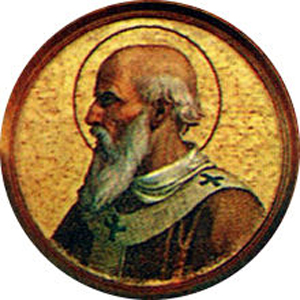 The mystery deepens when we consider that this exemplary Pope was expelled from the Universal Calendar by a later Pope without good reason.
The mystery deepens when we consider that this exemplary Pope was expelled from the Universal Calendar by a later Pope without good reason.
By no stretch of the imagination could Msgr. Bugnini’s fabricated criteria for suppressing feasts be applied to that of St. Leo II. This time there was no question of duplication: It was the only feast of St. Leo II in the Calendar.
Nor could it be rejected on the grounds of being “not historical”: The reign of Pope Leo was well documented and his writings preserved.
Any attempt to suppress the feast because it was “not of universal significance” (another of Bugnini’s pretexts to wield the hatchet) would be doomed to failure: Pope Leo’s endorsement of the Sixth Ecumenical Council (680–681) concerned a doctrinal matter which remained binding on all future Popes to uphold.
The situation obviously called for the deployment of all Bugnini’s powers of inventiveness and the use of a technique at which he was particularly adept – the sleight of hand that deceives the eye.
A game of ‘liturgical chairs’
The basic plan was to arrange for 3 Saints – Leo II, Irenaeus and Thomas the Apostle – to contend for 2 dates on the Calendar: June 28 and July 3, with only one Saint being allowed to occupy either day.
Before 1960, June 28 was the feast of St. Irenaeus (2) and July 3 that of St. Leo II. (3) But in the Reform of 1960, St. Irenaeus was moved to July 3 on the excuse that June 28 (the Vigil of Sts. Peter and Paul) should remain free. St. Leo was, therefore, completely supplanted.
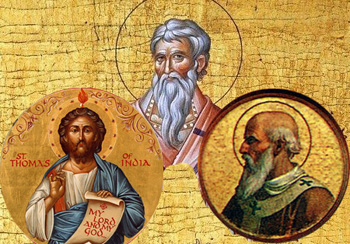 Then, in 1969, at the drop of a hat, St. Irenaeus was returned to June 28, which shows that it was not imperative for him to have been moved in the first place. But July 3 was not restored to St. Leo (who was, by then, conveniently forgotten by most people). It was given, instead, to St. Thomas the Apostle who was transferred from his traditional date of December 21.
Then, in 1969, at the drop of a hat, St. Irenaeus was returned to June 28, which shows that it was not imperative for him to have been moved in the first place. But July 3 was not restored to St. Leo (who was, by then, conveniently forgotten by most people). It was given, instead, to St. Thomas the Apostle who was transferred from his traditional date of December 21.
So, when the music finally stopped, St. Leo II was the one permanently left without a seat, a loss to the Church that went largely unnoticed in the swapping around of Saints’ days in the Calendar. Who now commemorates the feast of St. Leo II, or even knows that the greatest achievement of his pontificate was to confirm the posthumous excommunication of Pope Honorius I for complicity in heresy? (4)
The question remains as to why St. Leo had to be dropped from the Calendar.
When we come to examine the background to the 1960 reforms, we see that St. Leo II was predictably the loser in the game of liturgical chairs even before the music started to play.
In defense of Pope Leo II
But, first, a few words about Leo II. By excluding Honorius from the Church with the backing of an Ecumenical Council, Pope Leo II was simply fulfilling the highest duty of the Petrine office: to maintain the supernatural unity of the Faith throughout the Church for the good of souls.
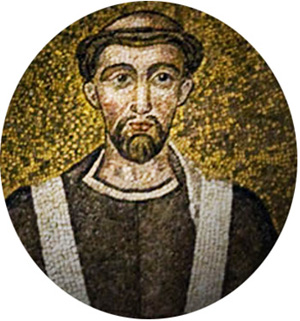 As the salvation of souls is the very reason for the establishment and continued existence of the Church, no Pope who fails to take effective steps against those who spread doctrinal error can be considered to have fulfilled the duties of his office. (5)
As the salvation of souls is the very reason for the establishment and continued existence of the Church, no Pope who fails to take effective steps against those who spread doctrinal error can be considered to have fulfilled the duties of his office. (5)
That was the charge against Pope Honorius – dereliction of duty. He was anathematized by the Sixth Ecumenical Council and by Pope Leo II, not for teaching heresy himself, but for his passive acquiescence and failure to use his authority to repress it. In the words of Pope Leo II, he “did not sanctify this Apostolic Church with the teaching of Apostolic Tradition, but by profane treachery allowed its purity to be stained.” (6)
This verdict was corroborated by the theologian and Doctor of the Church, St. Alphonsus Liguori. (7)
The difference between Leo II & John XXIII
The difference lies, on the one hand, in Leo II’s robustly traditional refusal to tolerate those who spread heresy or allowed it to take root in the Church and, on the other, John XXIII’s radically altered theology of papal governance (the “softly-softly” approach to error).
John XXIII declared in his opening speech at the Council that the Church “prefers today to make use of the medicine of mercy, rather than of the arms of severity” and to proceed “by showing the validity of her teaching, rather than by issuing condemnations.”
Romano Amerio, a known writer on Vatican II, noted that this position regarding doctrinal error was “a definite novelty, and is openly announced as being a new departure for the Church.” (8)
The departure was from authentic Catholic teaching and practice. The novelty consisted in presenting the condemnation of error – and punishment of its perpetrators – as being opposed to mercy. But, as the Church’s mission is to fight evil and save souls through conversion to the Truth, Pope Leo II’s condemnation of error was itself a Work of Mercy – in fact, one of the Seven Spiritual Works of Mercy.
Romano Amerio, echoing the perennial teaching of the Church, pointed out:
“Two things are needed to maintain truth. First: remove the error from the doctrinal sphere, which is done by refuting erroneous arguments and showing that they are not convincing. Second: remove the person in error, that is, depose him from office, which is done by an act of the Church’s authority.” (9) [Emphasis in the original]
This discrepancy between the two Popes shows the extent to which the “new theology” of Vatican II is irreconcilable with the traditional defense of Catholic doctrine exemplified by Pope Leo II.
The Vatican II Popes soft on heresy
Pope Paul VI lamented the massive and open dissent from the teaching of the Magisterium among the Hierarchy. But dissident Bishops, priests, theologians and seminary professors were left in place to go on publicly criticizing and undermining the Church’s teaching, and leading countless souls astray.
Amerio explained how Pope Paul VI dealt with those who rejected the Magisterium:
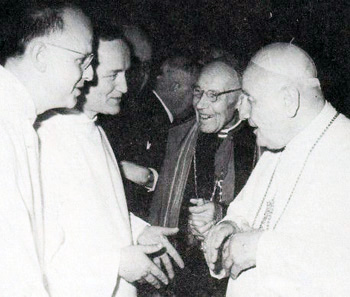
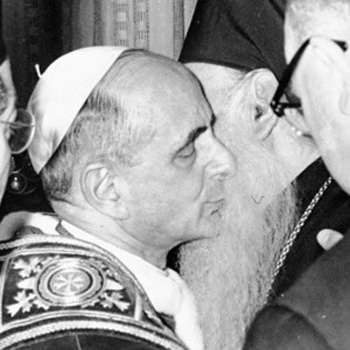 “Paul VI preferred to give speeches and warnings which recalled people to their duty without condemning them, made them aware of something without putting them under an obligation, and gave directions without insisting that they be followed.” (10)
“Paul VI preferred to give speeches and warnings which recalled people to their duty without condemning them, made them aware of something without putting them under an obligation, and gave directions without insisting that they be followed.” (10)
It has escaped the notice of most Catholics today that the Pope’s reluctance to apply the penalties of the law against unrepentant dissidents is part of the reason why they persisted in their errors.
All the evidence shows that the new policy of not disciplining and removing dissident clerics has already had the following effects:
Exit St. Leo II
The issue at the heart of Pope Leo’s expulsion from the Calendar is the changed concept of the Papacy. This 7th century Pope did not simply admonish, but took firm action against the source and spread of heresy, not sparing one of his Predecessors. He was, therefore, a “sign of contradiction,” a direct affront to the Vatican II Popes who allowed a swarm of heresies to invade and take residence in the Church – all in the cause of Ecumenism, Religious Liberty and Collegiality.
With the disappearance of St. Leo II from the liturgical scene, few people nowadays see the connection between the dogmatic and moral collapse that is evident around us and the failure of the modern Popes to deal effectively with the crisis.
In this new situation, a choice has to be made. Are we for the Catholic Faith or against it? Are we for opposing Honorius (and his modern counterparts), or for allowing them to perpetuate error and heresy? Are we for defending the Church, or for conciliating those who want to destroy it? There is no middle way possible here. This is where the sword of St. Michael divides.
Continued


Pope Leo II: Expelled from the Calendar for condemning Honorius' complicity with heresy
By no stretch of the imagination could Msgr. Bugnini’s fabricated criteria for suppressing feasts be applied to that of St. Leo II. This time there was no question of duplication: It was the only feast of St. Leo II in the Calendar.
Nor could it be rejected on the grounds of being “not historical”: The reign of Pope Leo was well documented and his writings preserved.
Any attempt to suppress the feast because it was “not of universal significance” (another of Bugnini’s pretexts to wield the hatchet) would be doomed to failure: Pope Leo’s endorsement of the Sixth Ecumenical Council (680–681) concerned a doctrinal matter which remained binding on all future Popes to uphold.
The situation obviously called for the deployment of all Bugnini’s powers of inventiveness and the use of a technique at which he was particularly adept – the sleight of hand that deceives the eye.
A game of ‘liturgical chairs’
The basic plan was to arrange for 3 Saints – Leo II, Irenaeus and Thomas the Apostle – to contend for 2 dates on the Calendar: June 28 and July 3, with only one Saint being allowed to occupy either day.
Before 1960, June 28 was the feast of St. Irenaeus (2) and July 3 that of St. Leo II. (3) But in the Reform of 1960, St. Irenaeus was moved to July 3 on the excuse that June 28 (the Vigil of Sts. Peter and Paul) should remain free. St. Leo was, therefore, completely supplanted.

St. Thomas the Apostle, St. Iraeneus, Pope St. Leo II - when the game ended, Leo II was left out
So, when the music finally stopped, St. Leo II was the one permanently left without a seat, a loss to the Church that went largely unnoticed in the swapping around of Saints’ days in the Calendar. Who now commemorates the feast of St. Leo II, or even knows that the greatest achievement of his pontificate was to confirm the posthumous excommunication of Pope Honorius I for complicity in heresy? (4)
The question remains as to why St. Leo had to be dropped from the Calendar.
When we come to examine the background to the 1960 reforms, we see that St. Leo II was predictably the loser in the game of liturgical chairs even before the music started to play.
In defense of Pope Leo II
But, first, a few words about Leo II. By excluding Honorius from the Church with the backing of an Ecumenical Council, Pope Leo II was simply fulfilling the highest duty of the Petrine office: to maintain the supernatural unity of the Faith throughout the Church for the good of souls.

Honorius I ‘by profane treachery allowed the purity of Apostolic Tradition to be stained’
That was the charge against Pope Honorius – dereliction of duty. He was anathematized by the Sixth Ecumenical Council and by Pope Leo II, not for teaching heresy himself, but for his passive acquiescence and failure to use his authority to repress it. In the words of Pope Leo II, he “did not sanctify this Apostolic Church with the teaching of Apostolic Tradition, but by profane treachery allowed its purity to be stained.” (6)
This verdict was corroborated by the theologian and Doctor of the Church, St. Alphonsus Liguori. (7)
The difference between Leo II & John XXIII
The difference lies, on the one hand, in Leo II’s robustly traditional refusal to tolerate those who spread heresy or allowed it to take root in the Church and, on the other, John XXIII’s radically altered theology of papal governance (the “softly-softly” approach to error).
John XXIII declared in his opening speech at the Council that the Church “prefers today to make use of the medicine of mercy, rather than of the arms of severity” and to proceed “by showing the validity of her teaching, rather than by issuing condemnations.”
Romano Amerio, a known writer on Vatican II, noted that this position regarding doctrinal error was “a definite novelty, and is openly announced as being a new departure for the Church.” (8)
The departure was from authentic Catholic teaching and practice. The novelty consisted in presenting the condemnation of error – and punishment of its perpetrators – as being opposed to mercy. But, as the Church’s mission is to fight evil and save souls through conversion to the Truth, Pope Leo II’s condemnation of error was itself a Work of Mercy – in fact, one of the Seven Spiritual Works of Mercy.
Romano Amerio, echoing the perennial teaching of the Church, pointed out:
“Two things are needed to maintain truth. First: remove the error from the doctrinal sphere, which is done by refuting erroneous arguments and showing that they are not convincing. Second: remove the person in error, that is, depose him from office, which is done by an act of the Church’s authority.” (9) [Emphasis in the original]
This discrepancy between the two Popes shows the extent to which the “new theology” of Vatican II is irreconcilable with the traditional defense of Catholic doctrine exemplified by Pope Leo II.
The Vatican II Popes soft on heresy
Pope Paul VI lamented the massive and open dissent from the teaching of the Magisterium among the Hierarchy. But dissident Bishops, priests, theologians and seminary professors were left in place to go on publicly criticizing and undermining the Church’s teaching, and leading countless souls astray.
Amerio explained how Pope Paul VI dealt with those who rejected the Magisterium:

Above, John XXIII exchanges cordialities with Protestant Roger Schutz; below, Paul VI kisses Schismatic patriarch Athenagoras

It has escaped the notice of most Catholics today that the Pope’s reluctance to apply the penalties of the law against unrepentant dissidents is part of the reason why they persisted in their errors.
All the evidence shows that the new policy of not disciplining and removing dissident clerics has already had the following effects:
- It has given the guilty parties an unmistakable signal that they will go unpunished;
- It has led to authority being ignored by those who are bound to obedience to it;
- It has brought authority into disrepute;
- It has ushered in the reign of liberalism in dogmatic and moral theology;
- Anarchy has reigned supreme in dogmatic and moral matters.
Exit St. Leo II
The issue at the heart of Pope Leo’s expulsion from the Calendar is the changed concept of the Papacy. This 7th century Pope did not simply admonish, but took firm action against the source and spread of heresy, not sparing one of his Predecessors. He was, therefore, a “sign of contradiction,” a direct affront to the Vatican II Popes who allowed a swarm of heresies to invade and take residence in the Church – all in the cause of Ecumenism, Religious Liberty and Collegiality.
With the disappearance of St. Leo II from the liturgical scene, few people nowadays see the connection between the dogmatic and moral collapse that is evident around us and the failure of the modern Popes to deal effectively with the crisis.
In this new situation, a choice has to be made. Are we for the Catholic Faith or against it? Are we for opposing Honorius (and his modern counterparts), or for allowing them to perpetuate error and heresy? Are we for defending the Church, or for conciliating those who want to destroy it? There is no middle way possible here. This is where the sword of St. Michael divides.
Continued
- “Vir eloquentissimus, in divinis Scripturis sufficienter instructus, greca latinaque lingua eruditus, cantelena ac psalmodia praecipuus.” See Louis Duchesne (ed.), Le Liber Pontificalis, Paris, 1886-1892, vol. 1, p. 359.
- This was only so from 1921 when Pope Benedict XV extended his feast (previously celebrated at Lyons) to the Universal Calendar. According to the Roman Martyrology, June 28 was traditionally the feast of St. Leo II at Rome.
- Ironically, July 3 (1982) was the day Archbishop Bugnini died in Rome. In the current state of the Church, it is not beyond the bounds of possibility that he might one day be “canonized” and that this date might become the feast of “Saint Annibale.”
- This was the Monothelite heresy which arose among the Patriarchs of Constantinople in the 7th century. They recognized the orthodox doctrine of the two natures of Christ (divine and human), but their doctrine that He had only one Will common to both natures was condemned as heretical by the Sixth Ecumenical Council in 681.
- How seriously the Church regarded this Petrine office can be seen from the words of Pope Leo’s predecessor, Pope St. Agatho (678-681), who addressed the Sixth Ecumenical Council thus:
“Woe is me if I neglect to preach the truth of my Lord, which they [the Roman Pontiffs] preached with sincerity. Woe is me, if I cover the truth in silence… What shall I say in the future examination by Christ himself, if I blush (which God forbid!) to preach here the truth of His words? What satisfaction shall I be able to give for myself, what for the souls committed to me, when He demands a strict account of the office I have received?” - He also wrote to the Spanish Bishops, blaming Honorius for not, as befitting his Apostolic authority as Pope, extinguishing the flames of heretical doctrine in the beginning, but fostering them by his negligence.
It is worth noting that one of Leo II’s Predecessors, Pope Martin I (649-655), died a martyr’s death at the hands of the Byzantine Emperor Constans II for having defended the Church against the Monothelite heresy which Pope Honorius had declined to combat. - St. Alphonsus stated: “Honorius can, by every right, be cleared from the Monothelite heresy, but still was justly condemned by the Council, as a favorer of heretics, and for his negligence in repressing error.” See The History of Heresies, and their Refutation, or the Triumph of the Church, 2 vols., Dublin: James Duffy, 1847, vol. 1, p. 199.
- Romano Amerio, Iota Unum: A Study of Changes in the Catholic Church in the 20th Century, Angelus Press, 1999, p. 80.
- Ibid., p. 145
- Ibid., p. 146
- St. Alphonsus Liguori agreed that Pope Honorius “was very properly condemned [by Leo II], for the favorers of heresy and the authors of it are both equally culpable.” (The History of Heresies, and their Refutation, or the Triumph of the Church, p. 194)

Posted Ausugst 2, 2019
______________________
______________________
 Volume I |
 Volume II |
 Volume III |
 Volume IV |
 Volume V |
 Volume VI |
 Volume VII |
 Volume VIII |
 Volume IX |
 Volume X |
 Volume XI |
 Special Edition |


